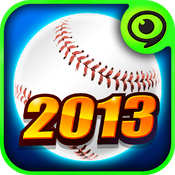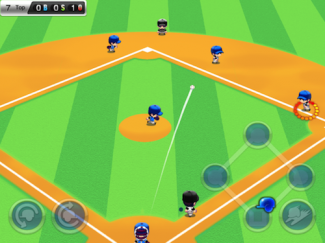Aperture Desk Job
LQ: 8.8
Recommended Age: 8+
Skills Used: Focus, Working Memory, Reading

Baseball Superstars 2013 is a mobile baseball game that features crisp, cartoonish graphics, simple touch-based controls and various forms of gameplay. "My batter" and "my pitcher" modes feature a story line where players must develop their batter or pitcher as they progress through a season for a fictional baseball team. The game also offers player-vs-player modes, as well as quests and daily challenges where players are assigned different game-to-game tasks. During gameplay, pitchers have an arsenal of pitches to choose from, and batters must adjust to the type of ball being thrown. Both hitting and pitching are fairly easy to master and are accomplished by simply swiping or tapping the screen. While the gameplay in Baseball Superstars 2013 is simple enough for children 4 and older, there are some female character models parents may find to be inappropriate, and a fair amount of reading is present. Due to these considerations, we recommend Baseball Superstars 2013 to players ages 10 and up with parental guidance.
Teachers: check out the classroom guide!
Adapting and adjusting to changing conditions and expectations.
 By nature, baseball is a "game of adjustments," as both hitters and pitchers are always fine tuning different aspects of their respective crafts. When playing Baseball Superstars, players must be aware when they must make a change to their approach. For example, if pitchers are walking too many batters, players must change the way in which they are swiping their fingers to control the location of the pitch. If batters players are frequently swinging and missing, they should develop more fine-tuned sense of what pitch is being thrown. Typically pitch speeds in the game vary from 65-100 miles per hour. The 35 mph variation requires players to adjust their swing to the speed and location of the pitch. When playing the "my batter" and "my pitcher" modes, the team's coach appears after every game and grades the performance. If players went 0-4 at the plate, they may receive a D but it they went 3-4 and drove in runs, the coach will give them an A. Players can use the feedback from their coach to improve their overall play, as he can help illuminate the areas that need improvement.
By nature, baseball is a "game of adjustments," as both hitters and pitchers are always fine tuning different aspects of their respective crafts. When playing Baseball Superstars, players must be aware when they must make a change to their approach. For example, if pitchers are walking too many batters, players must change the way in which they are swiping their fingers to control the location of the pitch. If batters players are frequently swinging and missing, they should develop more fine-tuned sense of what pitch is being thrown. Typically pitch speeds in the game vary from 65-100 miles per hour. The 35 mph variation requires players to adjust their swing to the speed and location of the pitch. When playing the "my batter" and "my pitcher" modes, the team's coach appears after every game and grades the performance. If players went 0-4 at the plate, they may receive a D but it they went 3-4 and drove in runs, the coach will give them an A. Players can use the feedback from their coach to improve their overall play, as he can help illuminate the areas that need improvement.
Focus
Getting started and then maintaining attention and effort to tasks, especially shifting attention.
 Setting realistic goals is an important skill to develop for school children. Lofty goals can often lead to feelings of disappointment, while goals that are short sighted will not challenge the individual. Goals give direction to daily life and lead to productivity. That is why it is important to have strong goal directed persistence, or the drive and motivation to set out and complete an activity, assignment, or dream. In the "my batter" and "my pitcher" gameplay modes, players are asked to choose three very specific goals for their players. For batters those goals could be to hit .290, or achieve a certain slugging percentage. Players should choose goals they feel confident they can complete, as succeeding will garner players "g points," which allows them to purchase in game items, train their players, and unlock hidden levels and characters.
Setting realistic goals is an important skill to develop for school children. Lofty goals can often lead to feelings of disappointment, while goals that are short sighted will not challenge the individual. Goals give direction to daily life and lead to productivity. That is why it is important to have strong goal directed persistence, or the drive and motivation to set out and complete an activity, assignment, or dream. In the "my batter" and "my pitcher" gameplay modes, players are asked to choose three very specific goals for their players. For batters those goals could be to hit .290, or achieve a certain slugging percentage. Players should choose goals they feel confident they can complete, as succeeding will garner players "g points," which allows them to purchase in game items, train their players, and unlock hidden levels and characters.
Managing our actions, feelings and behaviors.
Just as important as reading an incoming pitch is the ability to correctly time swings, inhibit impulse hitting and learn to control actions with precision. It is easy to get over-zealous and swing early when timing a swing, and learning to delay a swing can sometimes lead to major improvements in the game. Conversely, players who are too pensive may miss hitting opportunities all-together, so it is important to strike a balance. Frequent setbacks can also lead to frustrations, but the game rewards players who stick to it and players are always allowed to try again, making the game a good tool for modeling self-regulation of affect.
All membership plans come with full access to our entire suite of tools learning guides, and resources. Here are a few of the ones we think you’ll like the most: